This recipe for old-fashioned vinegar pie will make you feel like one of those hardy pioneer bakers who were able to make something delicious from almost nothing.
It is so good and easy to make! If you’re a fan of old-fashioned desperation pies, another favorite to try is a classic Indiana sugar cream pie.
For ease of browsing, here are all of my pie and tart recipes in one place. Thanks for stopping by!
Pastry Chef Online Participates in Affiliate Programs. If you make a purchase through one of my links, I may earn a small commission. For more information click to read my disclosure policy
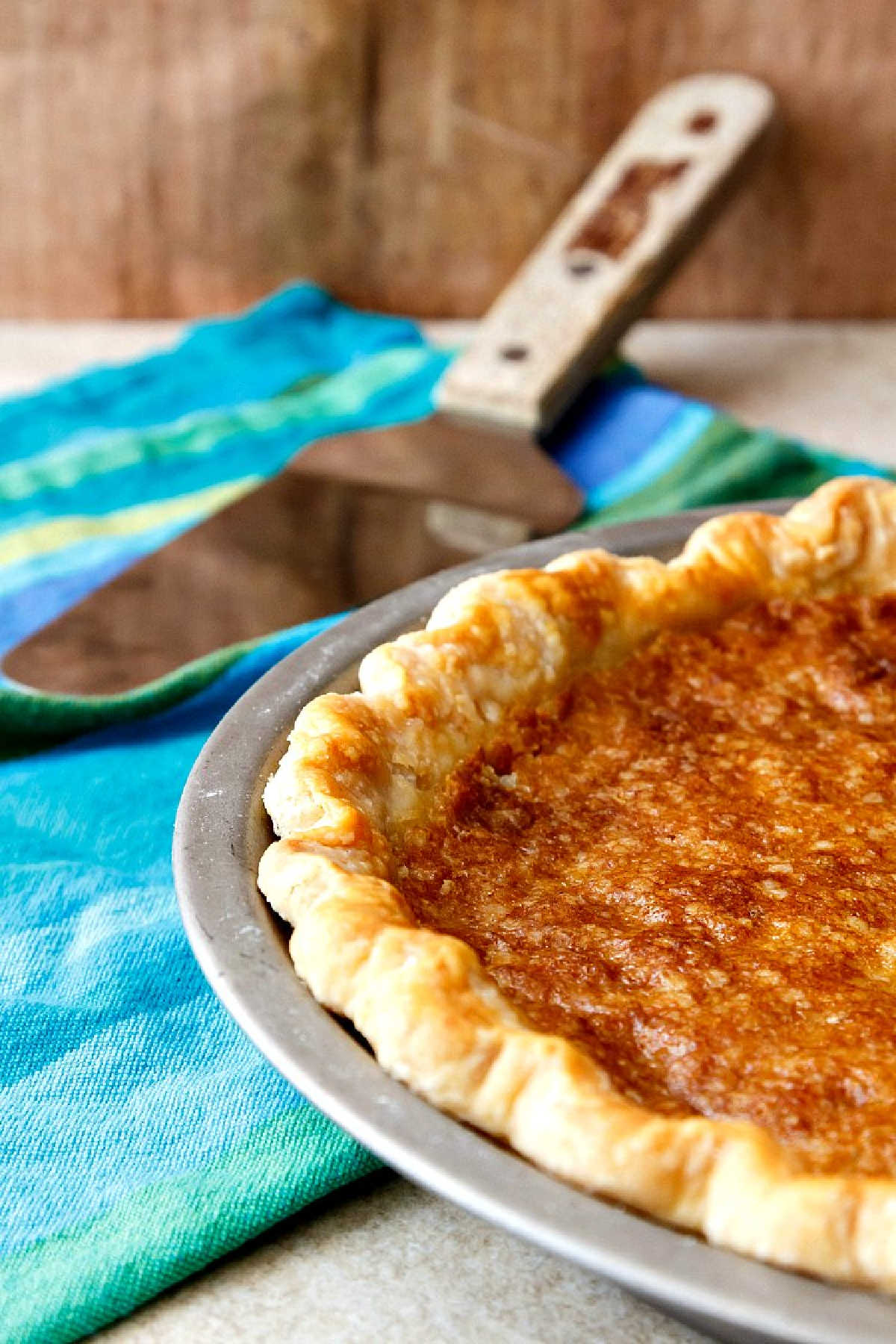
Watch my vinegar pie web story here.
Vinegar Pie, At a Glance
✔️Skill Level: Beginner
✔️Skills: Lining a pie tin with dough, whisking
✔️Type: Pie
✔️Number of Ingredients: 6
✔️Prep Time: 10 minutes
✔️Cook Time: 35 minutes
✔️Yield: 8 servings
Related Recipe: Pate Brisee
Jump Straight to the Recipe
Freaking awesome pie! Good thing Pioneer days included lots of hard manual labor or else everyone would have weighed 400 pounds if this was the pie of choice. Very rich, sweet and just satisfying. Going into my regular rotation of pies. Love old pie recipes and this one will be one that is turned to time and again.
Reader Scott
Pies in Time of Desperation
Sometimes, you just need something sweet. Something simple to throw together with a few pantry staples, something soul-satisfying and made with love. Sometimes you just need pie.
These days, most Americans are very fortunate to have ingredients handy to make fruit pies or chocolate pies whenever we feel like it, but back in the days before refrigeration, before huge supermarkets with all their bounty from all over the world, our pie-loving forebears had to be pretty creative in order to have pie in the dead of winter.
These pies relied on staples that were almost always available. Flour, butter from a cow, and water = pastry, and the fillings were based on other pantry stand-bys like:
- molasses (shoo fly pie)
- sorghum (sorghum pie)
- cream (sugar cream pie),
- cornmeal (chess pie and its variations like chocolate chess pie)
Eggs were almost always available because most people had chickens but if you’re out of eggs, try that sugar cream pie which is thickened entirely with flour.
And there you had it: desperation pies. A pie whenever you needed a sweet pick-me-up between the distant memory of bright crimson and golden leaves and the much longed-for buds of May.
If you know this is a pie you want to make, you can skip straight to the recipe.
But Vinegar Pie? Really?
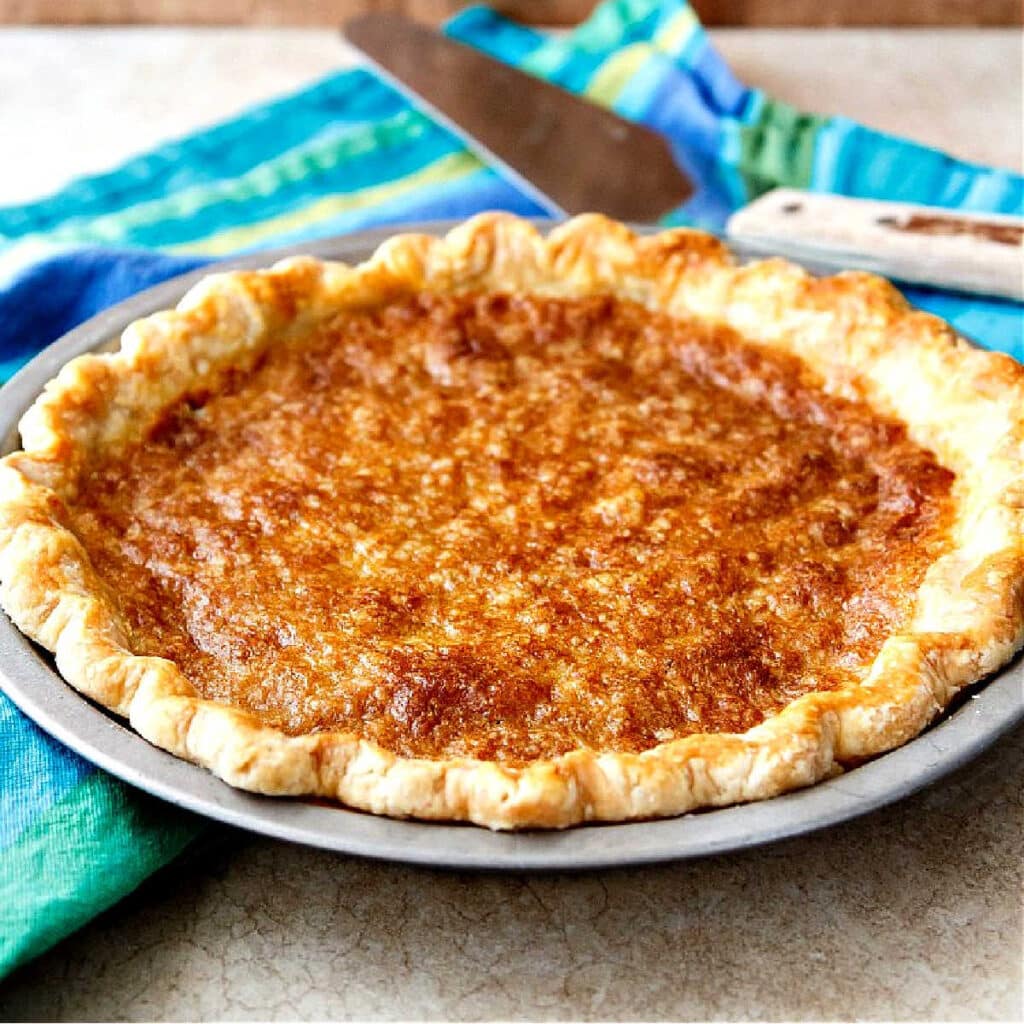
I hear you. I mean, of all the desperation and “pioneer pies” I’ve ever heard of, old-fashioned vinegar pie seems to be the most desperate kind of pie, you know?
The pie is like an answer to a challenge.
Two pioneer women are talking about what they could make out of not-a-lot, and then one says to the other, “I bet you can’t make a pie out of nothing, Marjorie.”
Marge, always up for a challenge, pushes up her sleeves, adjusts her bonnet, tightens her apron strings, and is all, ‘Hold. My. Beer, Blanche.”
I think you’ll get over the weirdness once you realize the pie isn’t made mainly of vinegar. It’s not like a sliceable sweet and sour sauce.
The vinegar in this pie is used as a flavoring agent. Like vanilla. There’s just enough of it in the mix to bring a nice tartness to round out the sweetness.
It reads as a “lightly lemon pie,” not as a pie full of vinegar.
The rule “you catch more flies with honey (or in this case, sugar) than you do with vinegar” is still true.
Nobody is going to eat a pie that has a cup of vinegar in it, least of all me.
History of Vinegar Pie
Okay, so maybe my “hold my beer” scenario is pure fiction. But the real story? It’s just as scrappy–the story of resourceful bakers who just really wanted a pie.
Carissa from the blog Pretty Hungry dug up a fun fact: Laura Ingalls Wilder actually wrote about this pie!
Apparently, her mom made all kinds of desperation pies while they lived in that little house on the prairie (or in the big woods, or wherever they lived when Charles might have said, ‘Hey hon, make me a pie!’ in the middle of winter.)
And if you think I’m the only one who loves a vinegar pie, my one-act play over on Instagram got a ton of love—including from some very well-known bakers and cookbook authors. Turns out, I’m not alone in my admiration for this scrappy little pie.
It is my feeling that the history of vinegar pie is the same history as all the other desperation pies.
Someone, somewhere wanted pie.
And that someone decided they were going to make pie out of whatever was available.
I am not sure there was a single person that invented this pie.
Would you like to save this post?
It was probably a bunch of able and creative (and desperate) home bakers who all said something along the lines of “I have eggs, sugar, and vinegar. I’mma make a pie. Hold my beer.”
And that’s it, friends. I hope you give the pie a try, and I really hope you love it.
How to Make the Most Desperate of the Desperation Pies
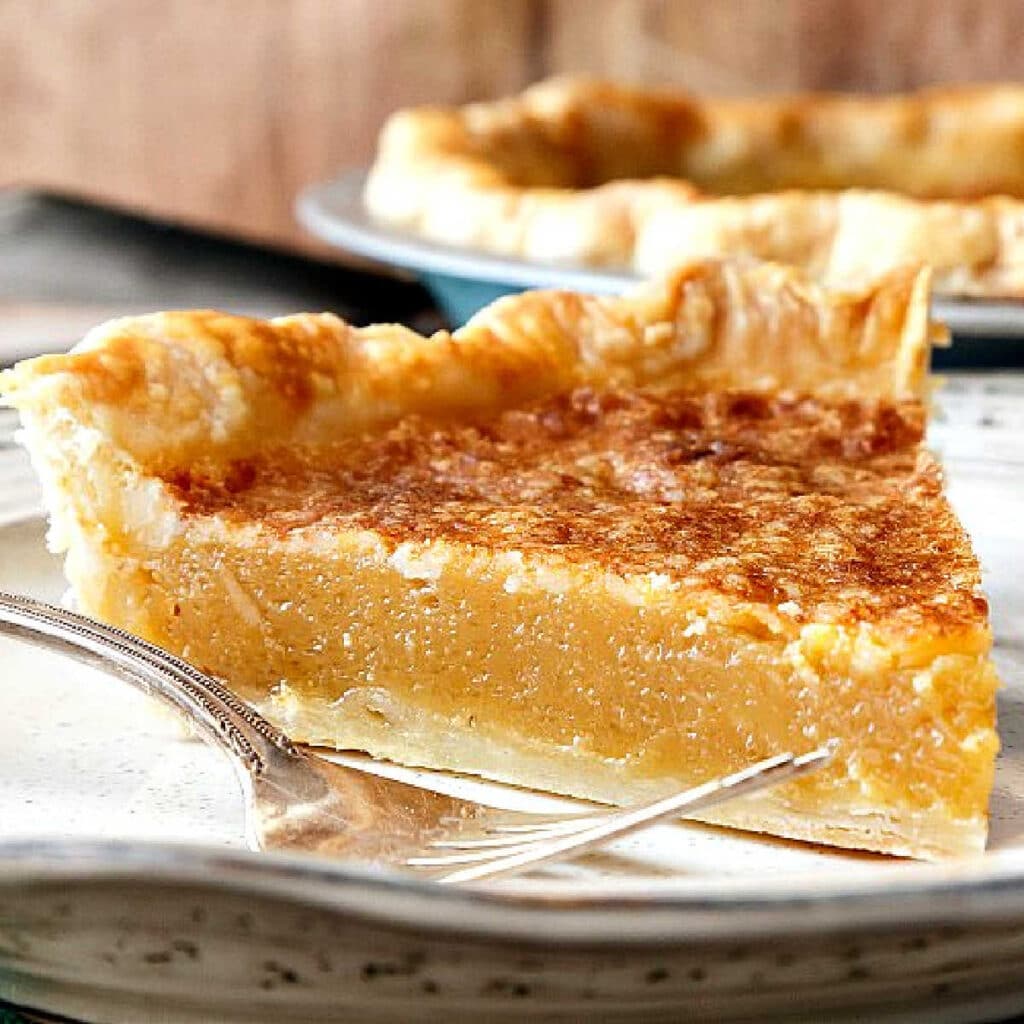
Growing up in the UP, Michigan. The depression and snowed in for weeks this was a favorite recipe we loved. They baked from memory. So, I’ve tried so many times to be disappointed. This was it! The brown sugar was the key. Took me back to childhood! Perfection.
Pinner PJ
Ingredients
Here are the ingredients you’ll need to make vinegar pie.
If you’re comfortable with making pie, you can jump straight to the recipe.
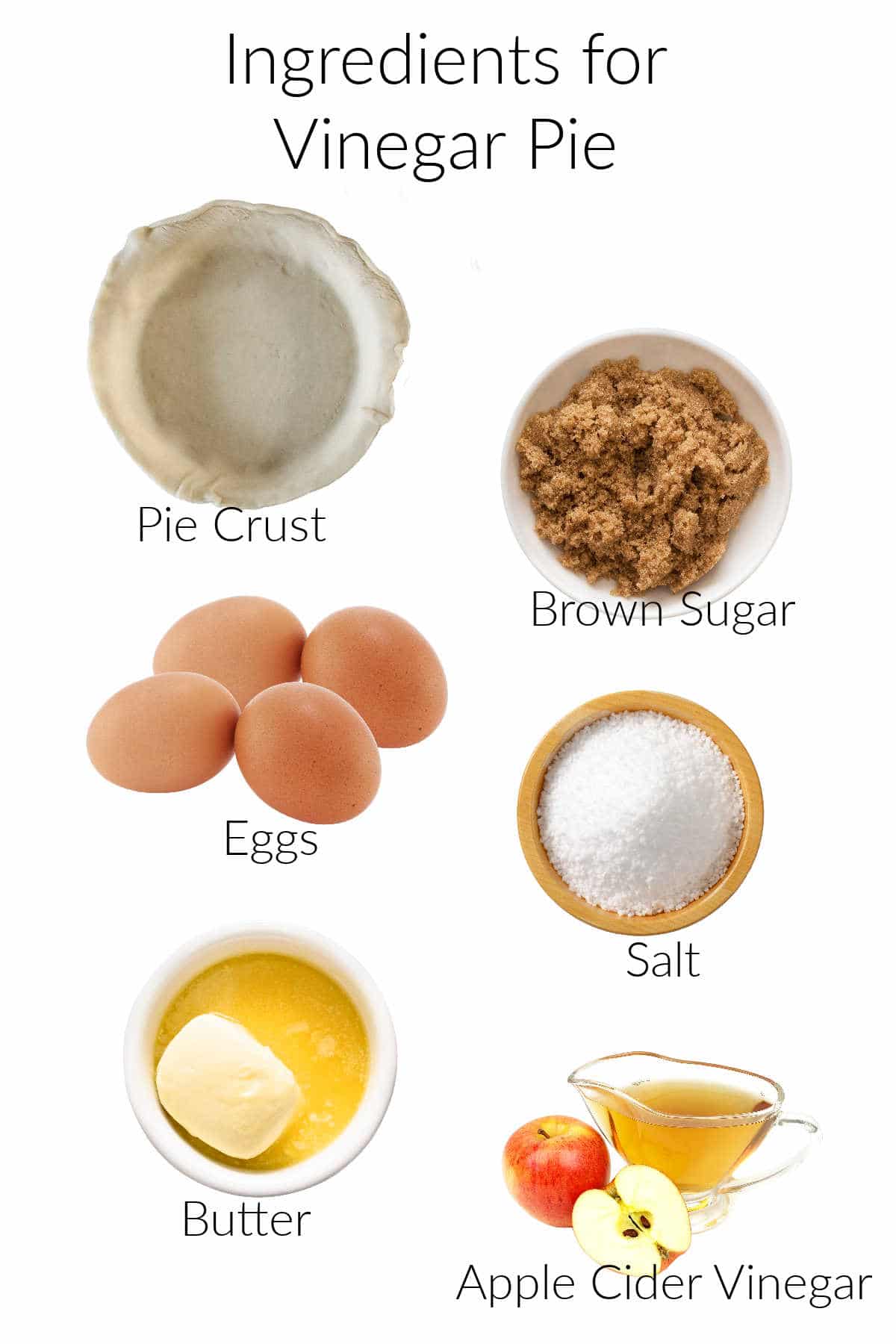
- pie crust: feel free to make your own, or use frozen store-bought. I use pate brisee which is an all-butter crust.
- eggs: you can use 3 or 4. Using four eggs will give you a firmer, more easily sliceable set. If you use 3 eggs, your pie will be a bit softer and creamier. There is no wrong answer here–it all depends on your taste. But there are no substitutes here. You need the eggs.
- brown sugar: brown sugar provides sweetness and a bit of flavor from the molasses. You can use honey if you prefer, but just remember that this will add more liquid to the pie, so don’t go crazy with it. And in this case, I’d go with the four eggs.
- melted butter: adds richness, helps to carry flavor, and assists with browning. I give two amounts of butter. You can use more or less, depending upon your taste. Please note that the butter may seem to separate out of the pie and make the top look slick, but it will reabsorb as the pie cools.
- salt: brings out all the flavors and counteracts any bitterness you might get from the apple cider vinegar
- apple cider vinegar: provides the acidic flavoring of this pie so that it reads as almost a lemon pie. And yes, you could absolutely top this with meringue to make a “desperation lemon(ish) meringue pie.” Or just step into the modern world and make a lemon meringue tart.
Jenni Says: Why use apple cider vinegar? Most folks out there on the prairie made their own vinegar, and, since they were widely available (thanks, Johnny Appleseed), I expect they used apples as the base.
Procedure
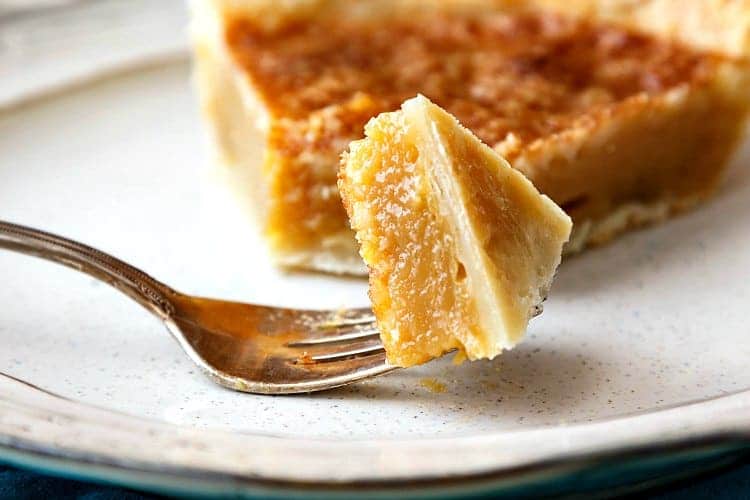
- Make a pie crust (optional. You can also buy one)
- Whisk the brown sugar, eggs, salt, butter, and apple cider vinegar together.
- Pour the filling into the pie crust, and bake.
For those of you who are thinking, “It can’t be this easy,” trust me. It is that easy.
Do I Need to Blind Bake?
Jenni Says: I am pretty sure the pioneers didn’t take time to parbake or blind bake their crusts, but to ensure browning on the bottom of the pie, you may want to do that. Here’s how to blind bake a pie crust.
I hope I’ve made my case for the tastiness of this pie.
As I said in the recipe, I used brown sugar rather than white. I figure a pie “seasoned” only with a bit of salt and vinegar (chips! No, not chips) might need the additional flavor of molasses.
Anyway, I hope you give it a try and that you enjoy it very much.
As unlikely as it sounds, I think this homey pie will win you over with how easy it is to make and how easy it is to eat!
Serving Suggestions
Vinegar pie is a simple pie and can stand on its own.
If you do want to serve it with something, stick with simple garnishes. A light dusting of powdered sugar would be welcome, or consider spooning on a bit of hand-whipped cream and maybe a handful of berries.
Questions?
If you have any questions about this post or recipe, I am happy to help.
Simply leave a comment here and I will get back to you soon. I also invite you to ask question in my Facebook group, Fearless Kitchen Fun.
If your question is more pressing, please feel free to email me. I should be back in touch ASAP, as long as I’m not asleep.
A Note About Measurements
My recipes are almost all written by weight, including liquids, unless otherwise specified.
For accuracy and consistency of results, I encourage you to buy–and use–a kitchen scale.
I promise that baking and cleanup will be so much quicker and easier.
This is the scale that I recommend for home use. I have owned and used one for years.
Don't let its small price and small size fool you. The Escali Primo is an accurate and easy-to-use food scale that I have used for years. It's easy to store, easy to use, has a tare function, and easily switches between grams and ounces/pounds for accurate measurements.
Love Vinegar Pie? Please Rate and Review. Thank you!
It will help me and other readers so much if you take a moment to rate and leave a review for this recipe.
You can use the stars to rate 1-5 (5 is best), and leave a review in the comments. It helps me make adjustments if any are needed, and comments help others decide whether the recipe is worth making.
Other ways to share include pinning, and/or sharing on your favorite social media platform.
Thank you so much for taking the time!

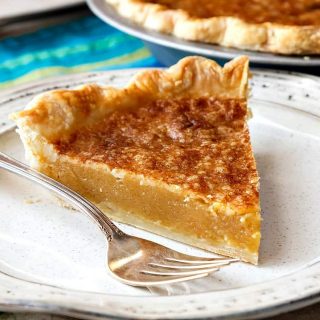
Old-Fashioned Vinegar Pie Recipe
Video
Would you like to save this post?
Equipment
Ingredients
- 1 crust for a single crust pie your favorite recipe or store-bought
- 3-4 large eggs at room temperature (three will give you a softer set)
- 1 cup light brown sugar* packed
- ½ teaspoon kosher salt I used Morton’s (yes, that much)
- 6 Tablespoons unsalted butter 3/4 sticks**, melted and cooled slightly
- 2 Tablespoons apple cider vinegar
Instructions
For the Crust
- Line a 9″ pie pan (not deep dish) with your pastry. Crimp however you’d like.
- Line the crust with parchment or a large coffee filter and then fill it with beans or other weights. Bake for 15 minutes at 350F.***
- Carefully remove lining and weights and set aside. Brush crust all over with egg wash (1 egg beaten well with a pinch of salt). Prick the bottom crust well with the tip of a sharp knife, and then bake an additional 10-15 minutes, or until the bottom of the pie crust looks dry. If the crust bubbles up at all with air pockets, carefully press them out.**
- Remove the crust from the oven and set aside. The crust will be pale. It’s okay, it will bake some more once you put the filling in.
For the Filling
- Whisk together the eggs, sugar, and salt until well combined and smooth.
- Drizzle in the melted butter while whisking constantly.
- Whisk in the apple cider vinegar.
- Pour into the crust and bake for about 35 minutes, or until the internal temperature of the pie is 165F. The filling will rise up and be nicely browned on the top. It will sink back to level as it cools.
- Remove pie from oven and cool to room temperature. Serve at room temperature or slightly chilled from the fridge. Store any leftovers in the refrigerator.
Did You Make Any Changes?
Notes
Nutrition
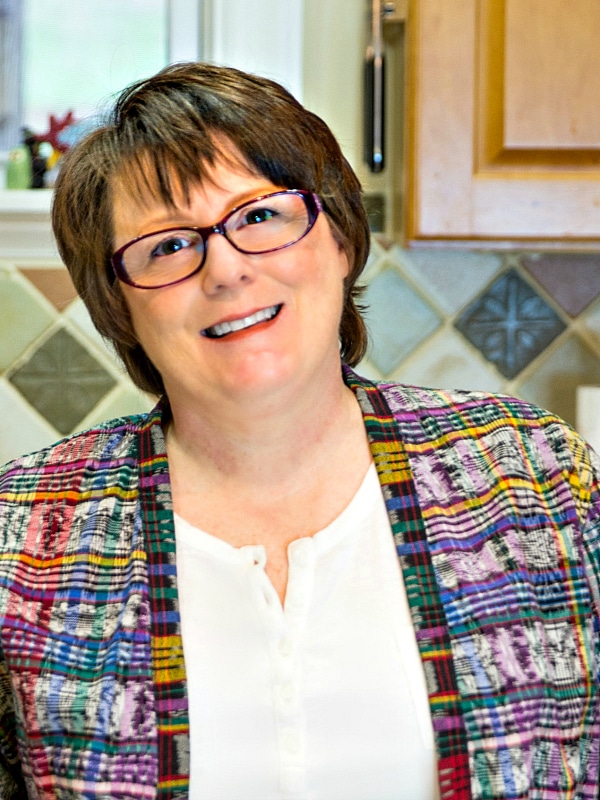
Hi, y’all! I hope you’ve enjoyed this post and hopefully also learned a thing or two.
If you like my style, I invite you to sign up for my occasional newsletter, The Inbox Pastry Chef.
Expect updates on new and tasty recipes as well as a bit of behind-the-scenes action. I hope to see you there!
Thanks for spending some time with me today, friends.
And remember, you don’t have to wait until desperation sets in to make vinegar pie!
Take care, y’all!

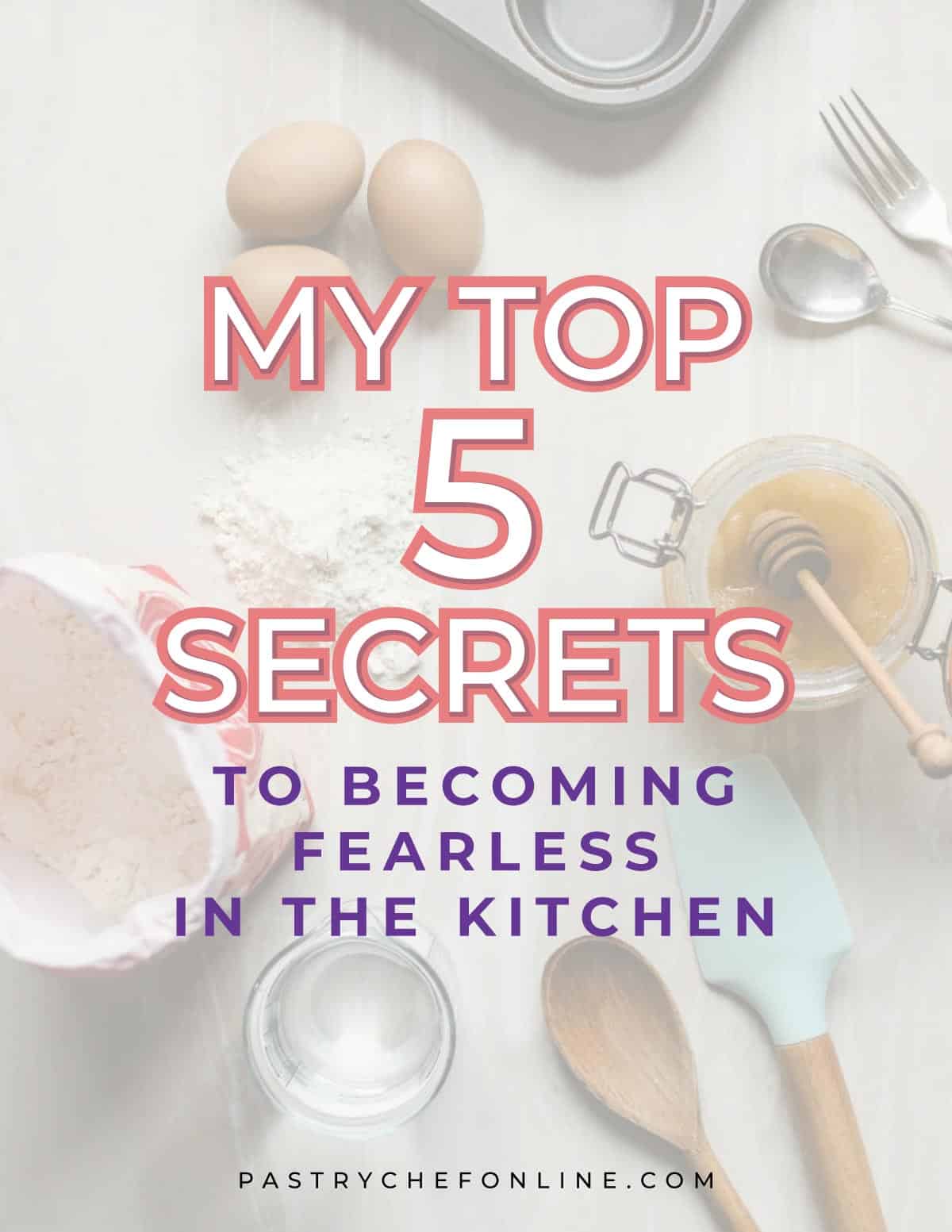
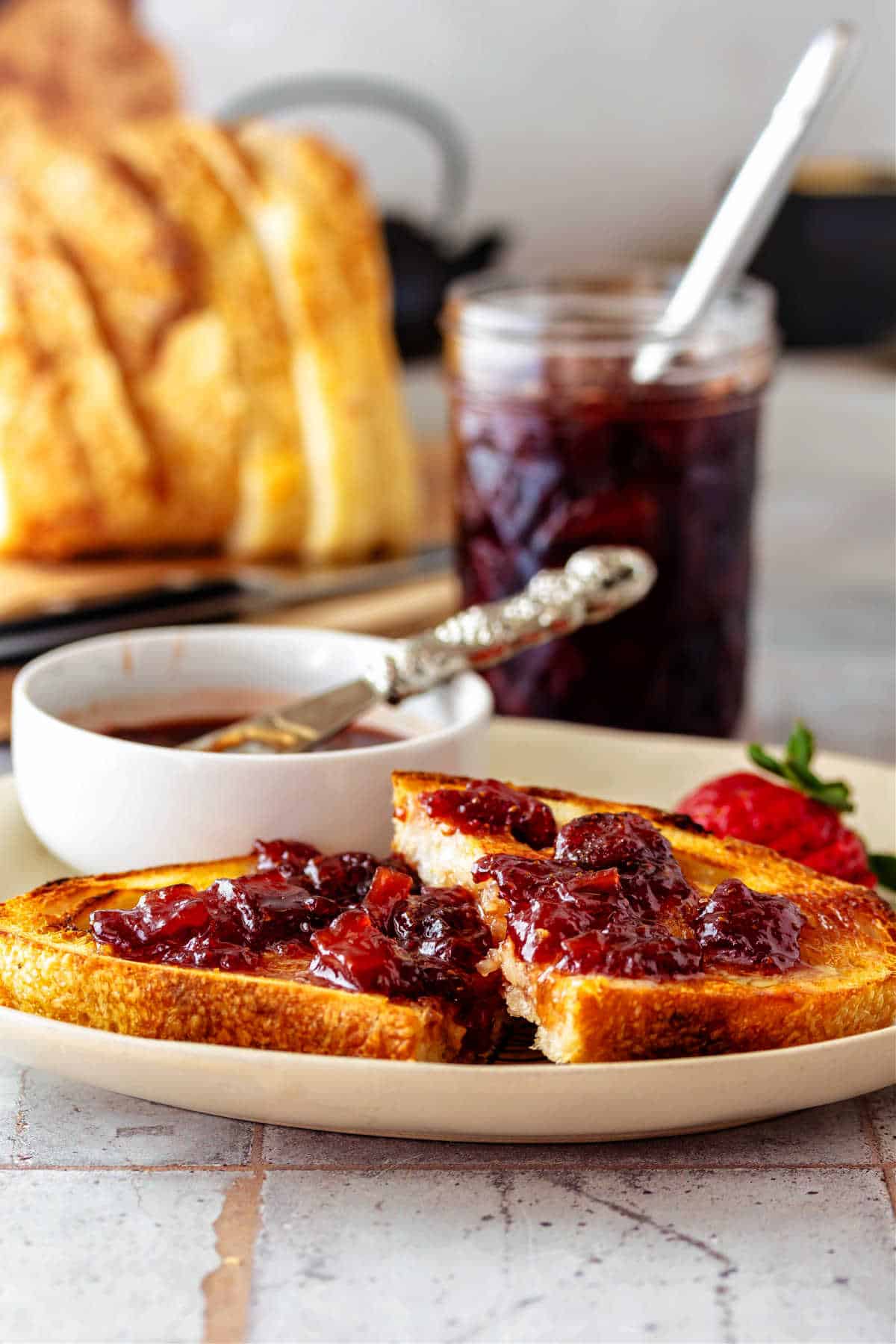
Join in Today!
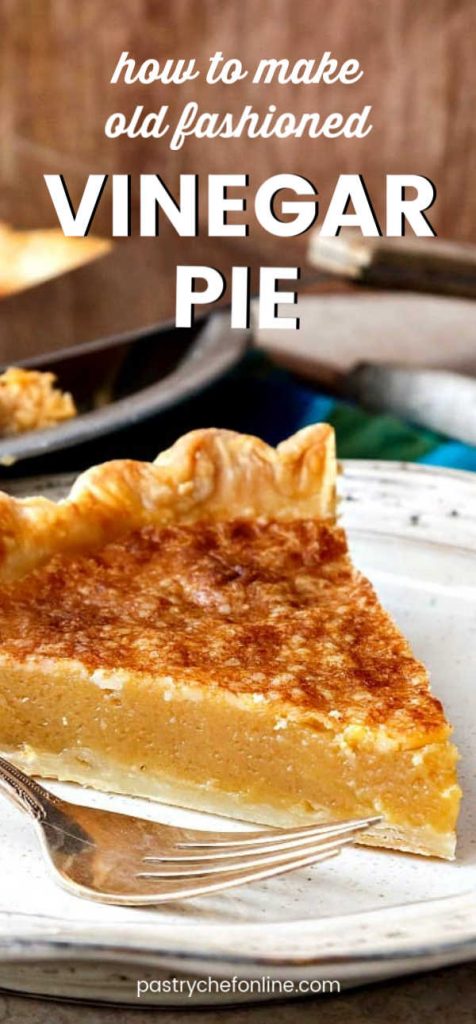
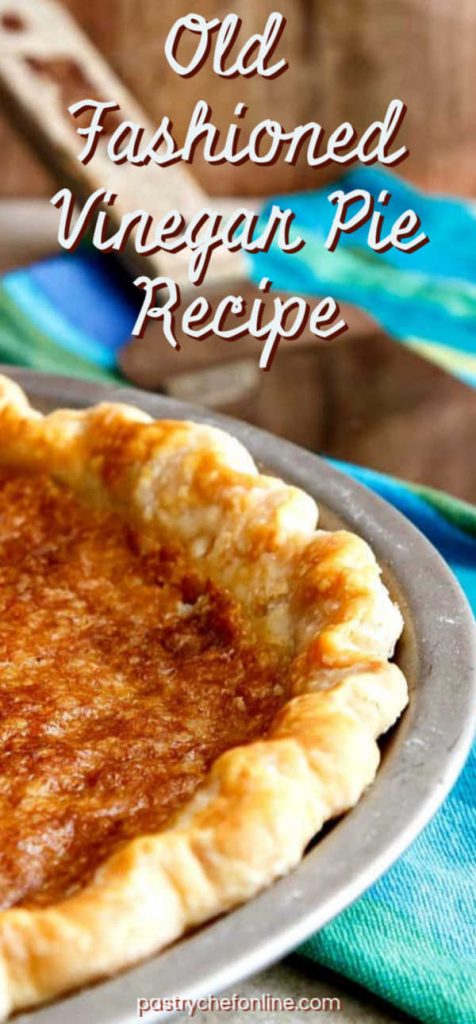
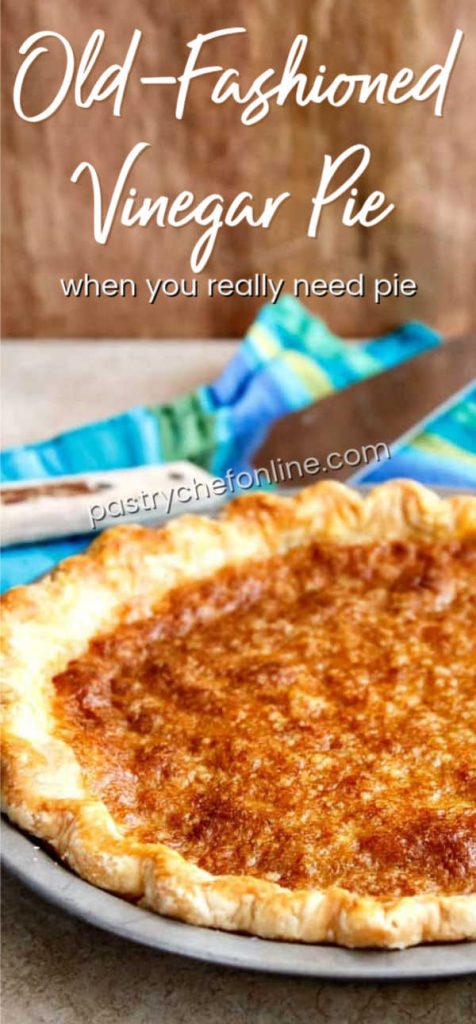
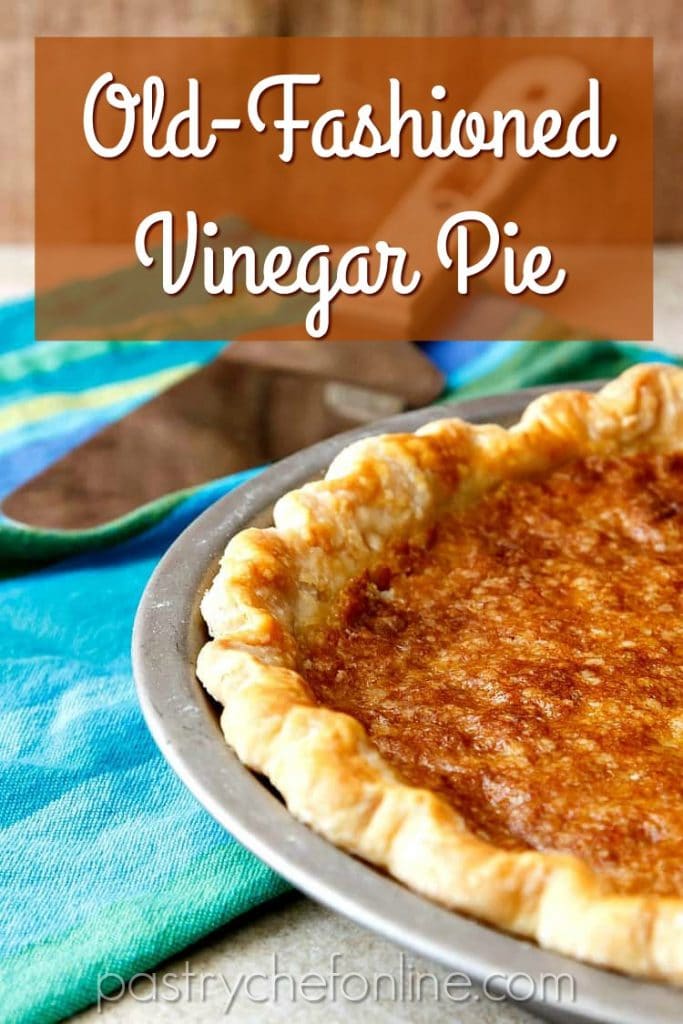
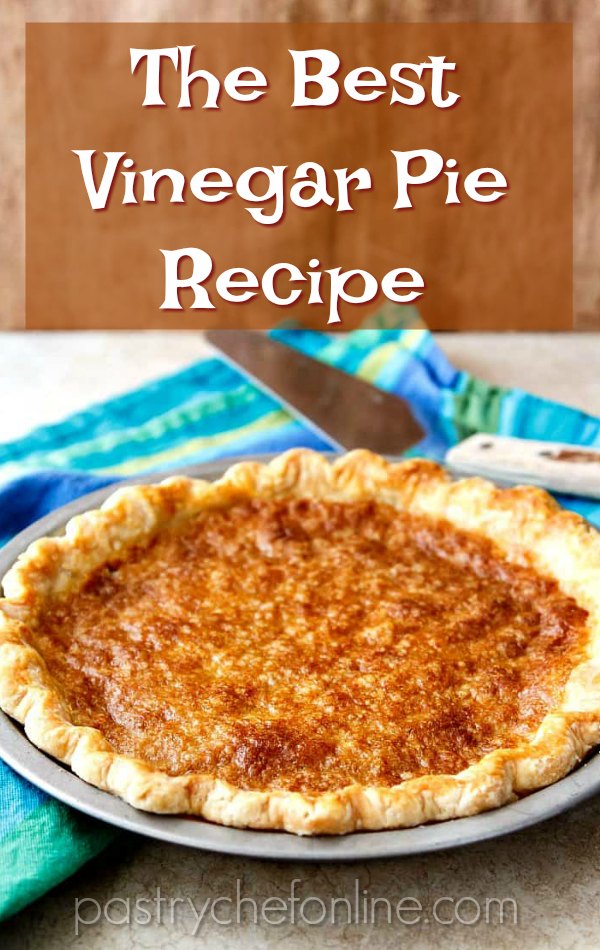
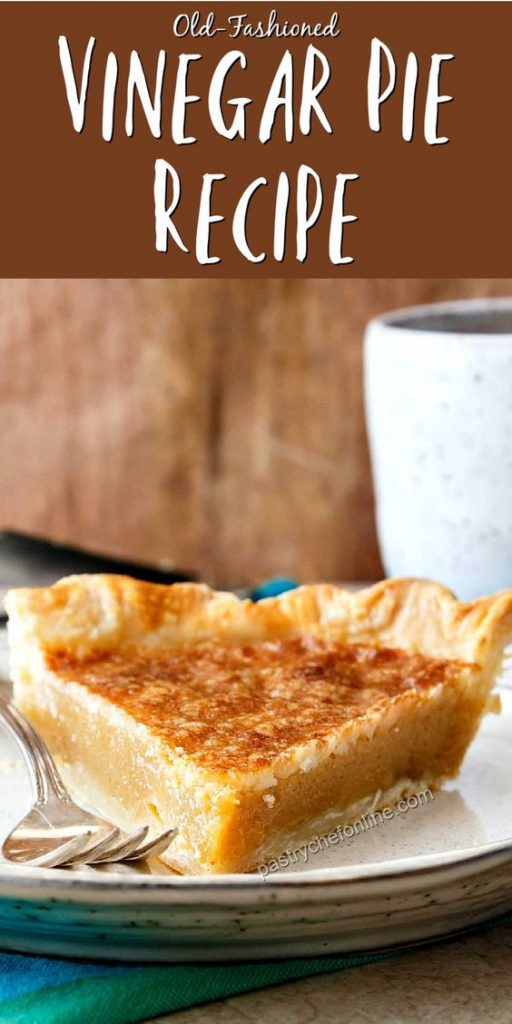



Does anyone know about making this into Bars?
You could absolutely make these as bars becaise the filling slices beautifully. Use the 4th egg to ensure a good set and bake in an 8 x 8 square pan. Enjoy!
This was one of my daddy’s favorite pies! He asked my auntie to make one before he passed. I have been looking for a good recipe since my auntie passed as well before I could ask her for it. This was spot on! Thank you so much for sharing!
I’m so glad this version fit the bill, Mena!
Very nice and easy
Glad you enjoyed it, Nanajee!
I love this pie! My Mamaw would make a vinegar pie occasionally – she could make a pie out of anything and made a pie every morning. Some of my other favorites are oatmeal, sugar cream, green tomato, gooseberry, plum, persimmon, pawpaw, and grape. Thankfully I had her give me the “recipes” before she passed. The key was to “just hold your mouth right”.
I’m so glad you had the foresight to get your grandma’s recipes!
This vinegar pie came out perfectly. This one was the most successful pie for me! I will definitely make this recipe again. Thanks.
Oh, I’m thrilled! Thanks so much for letting me know!
I came across this recipe randomly and can’t wait to try it. Just wanted to say that it really warmed my heart and renewed my faith in humanity to see how you responded so kindly and generously to all the commenters here, even the inexplicably rude ones! ❤️
Hey, Amanda! I’m so glad you’re here and that you’re excited to try the recipe. I really hope you enjoy it. 🙂 And, even if my first, knee-jerk reaction is to respond with snark, I just tell myself “It costs nothing to be kind.” Happy Thanksgiving!
Love the idea of this! If one were to use all lemon juice instead of vinegar, it be the same amount or would there need to be an adjustment? Thanks
Hey there, yes, I’d do a 1:1 substitution, but go ahead and use the zest of a lemon or two for a more floral lemon flavor. Should be really lovely. Enjoy!
Why can’t a deep dish pie she’ll be used? I spilled some of the sugar cream trying to put it in the oven.
There’s no hard and fast rule that you can’t, but this recipe won’t really fill a deep dish pie. Maybe if you multiply it by 1.5. If spilling is an issue, put the unfilled pie shell on a rack and then pour in the filling before gently pushing the rack in. Much less chance of spilling that way. Enjoy your pie!
Thanks for sharing this recipe. I wish I hadn’t ruined it! Somehow mine was a burnt scary wreck. But the filling tasty soooo good before pouring it in the crust. I will try again, but maybe in my convection oven. Haha
Yikes, I’m so sorry your oven betrayed you! Grab an inexpensive oven thermometer at the grocery store and make sure it’s heating accurately. I hope Round 2 works out well for you!
Cook time was WAY off for me, checked it at 25 mins and it was already about 175° 🙁
Interesting, but it probably worked out okay. 175 isn’t too too far off. Do you know if your oven is accurate? Did you use the convection setting? Either of these variables could affect the bake time. Let me know. Happy to help troubleshoot.
Freaking awesome pie! Good thing Pioneer days included lots of hard manual labor or else everyone would have weighed 400 pounds if this was the pie of choice. Very rich, sweet and just satisfying. Going into my regular rotation of pies. Love old pie recipes and this one will be one that is turned to time and again.
Oh, wonderful, Scott! I’m so glad you enjoyed it, and thanks for letting me know. Hope you have a great Thanksgiving!
Can the baked pie be frozen?
Custard pies, or in this case, an egg-set pie, don’t freeze as well as fruit pies. You can do it, but the pie will probably weep some when thawed and the texture may suffer. You can bake the pie a day ahead or up to 3 days ahead. For best flavor, cut slices and let them come up to room temperature for 30-45 minutes before serving. Hope that helps!
You shouldn’t use our LORD’S name in vain.
Duly noted.
Thanks for the recipe! I may have to make this again with some variations because I really did not enjoy it. I followed the recipe perfectly, but something didn’t work out. The flavor was just okay, but the “custard” was very firm and eggy, despite not overbaking. It was still liquidy when it came from the oven but tasted like a chewy omelet when it had cooled. I will try using three instead of four eggs next time. Otherwise, it was a very simple recipe. I did like the vinegar, as it added a little tang and was the perfect amount for the pie.
Yes, I suggest if you want a softer set to use 3 eggs, so it all depends on what texture you like. If you have an instant read thermometer, check the pie’s temp in the center and take it out when it hits 165F.
Thank you for the wonderful recipe. My aunt was telling me about her mother’s favorite pie and how she would love to have some. When she told me it was a vinegar pie I was like” WHAT DID YOU SAY, gross” lol but WOW what a great little slice of heaven this pie is. I used 3 eggs and I made one change, I added a little vinilla extract to mine and because of the moist cold weather we are having a few extre minutes in the oven but other than that I followed the recipe exact and a perfect pie, let me tell you, I watched my aunt go back in time one bite at a time and for that thank you very much
Oh, Ron, I am so glad you were able to give your aunt a slice of memory–that’s the best kind of baking possible, and I am so happy I was even a small part of that. And not that you need it, but I 100% support your modifications. Also, I’m really happy to hear that the texture with 3 eggs is so good. Next time I make this, I will use 3 instead of 4 also. I hope you have a wonderful and safe holiday, and thank you for this comment. It’s like a little Christmas gift.
Hi Jennifer!
Thanks for sharing this recipe. Seems pretty easy to follow. I wonder if you can offer any advice or opinion on what your thoughts are if I were to use balsamic instead of ACav? Do you think it’ll work?
Hey, Sha! Yes, this is a very easy whisk-everything-together kind of recipe. You *could* use balsamic, but I’d use white balsamic, just for aesthetics sake, because I think using dark balsamic would make the pie a pretty odd color. The tang of ACV cuts through the sweetness of the pie really well, so maybe consider using a mixture of the two, for that particular, rounded sweetness of balsamic with enough ACV for a little pucker factor. Whatever you decide to do, please let me know how it turns out for you!
This website on my phone is terrible. The social media buttons on the left and the favorite and search buttons on the right make anything on this site difficult to read. As if those buttons weren’t enough, there are more social media buttons on the bottom too. I had never heard of a vinegar pie and I tried reading here but I could only read the far left on the bottom of my screen and the far right on the top and middle of the page. It’s simply too much work scrolling up and down to read what I should be able to read just leaving my screen put for 30 seconds. I’ll search vinegar pie and go to another site to learn about them. Sorry.
Thanks for letting me know all of that. I guess if your screen is small, it could be really crowded. Sorry you had a hard time, and I’m sure you’ll find another good vinegar pie recipe at a different site. Take care, and be safe.
My 9-year-old learned about vinegar pie in school and asked that we try it out. She has some odd food allergies so we subbed coconut sugar for the brown sugar and ghee for the butter. I think the texture was perfect. The flavor needs work. In general, coconut sugar has a great caramel taste but is just not as sweet as brown sugar.
Lily couldn’t handle the texture (“epic fail, mom!”). Hubby would have liked it sweeter. We’ll try again — maybe using maple syrup next time.
Thank you for posting this recipe so we could try it out. I truly appreciate being able to find interesting recipes online 😀
Oh wow, thank you for commenting! I’m glad you consider a written recipe as a basis for experimentation. No recipe is one size fits all. Lily might like the texture more if you go with 3 rather than 4 eggs. Would love to hear how your continued experimentation goes, and I think the maple syrup idea is excellent!
I just watched someone win the Thanksgiving cooking contest on Food Network with a meal that included a pie similar to this.
The differences are that he used honey to sweeten it and, more important for my purposes, he also used a graham cracker-pretzel crust. I’ve been reading all the questions about pre-baking the crust on this page, and I thought maybe for those of us who are less than stellar bakers, it might be easier to avoid the regular pastry crust altogether, and just go with the easier pressed-crumb crust.
I *wondered* why everyone and their brother found this pie recipe last night! Mystery solved, Terri! And yes, you can absolutely use a Graham crust, especially if you are not super comfortable working with pie dough. You have now inspired me to develop a honey vinegar pie to go along with this one. I really hope you make one, and if you do, please let me know how you and your family enjoyed it, Terri! Thanks so much for commenting!
If I buy a store bought crust (pillsbury brand)..do I have to bake it first before putting the custard in? (that crust normally says to bake at 425*F) Or can I just put the filling in the unbaked crust and bake it all together? (At 350*F as your recipe states)?
Hey, Tracy. You can bake it straightaway, but since the box calls for a much higher temperature, I think you’ll be happier with the crust if you blind bake for a few minutes first. Line the crust with parchment or a large coffee filter, pour in pie weights or dry beans and bake the crust for 10 minutes or so at 425. Remove the parchment/filter and beans, make sure to prick the crust well with the point of a knife, and bake an additional 5 minutes before turning down the heat, adding the filling, and baking the pie. If the edges appear to be getting too dark before the pie is done, tent the pie loosely with foil. I hope you enjoy it!
Thanks so much! Can’t wait to try it!
I hope you and your family enjoy it!
It came out perfect 🙂
I’m so pleased! Yay!
Did you use 3 or 4 eggs? I will be making this for a pie lover and I do not bake very well!
I think you will prefer the texture with 3 eggs. Just whisk everything together and bake. I think you will end up with a Successful Pie! Enjoy!
Hi again! Thank you so much for the reply. One more question: If I use a store bought crust already in a tin pan, can I still “blind bake” it? The filling looks easy enough, but the crust scares me!
Yes, you can absolutely do that, Sally Ann. It’s a great time saver! I hope you guys enjoy!
Thank you so much for your answer! After some busy days I will certainly try again and let you know. But about the eggs. Did you beat the eggs very fluffy like for bisquit or just a little bit? Does it matter anyway? I thought that it was therefor so thick, that I didn´t beat the eggs correctly.
Thanks a lot for your help!
With very best cooking regards
Ruth
Glad I could help! No, everything is just whisked together until smooth, so you don’t have to beat the eggs like for meringue or sponge cake. Let me know how round 2 goes when you have the chance!
Thanks for this very exciting recipe. I tried it also, but I am sure that I overbaked it. Tasted well, but looked like an omelette. I also added 3 tablespoons of flour, but I read again and no flour was needed. But in what temperature you put it in the oven. I tried 170 degrees celsius for about 25 minutes. Today I am sure, temperature was too high. I will like to try again and not fail .
Thanks for your nice page and comments
With best regards
Ruth
Hi, Ruth! I’m glad you tried the pie and that you liked it enough that you want to give it another go. The recipe calls for 350F, so 170C was a good starting place. Maybe knock it back to 160-165C and keep an eye on it. I also like to check for doneness with an instant read thermometer. For a custard pie like this, you’ll shoot for 72-73C in the center. Mine took 35 minutes to bake. If you think it is browning too much on top, loosely cover the top with some foil. Please let me know how your second guy turns out, and thank you so much for leaving a comment. It’s nice to get feedback and I’m always happy to help by answering questions!
A little more background on vinegar pie. Back then when lemons were hard to come by in rural Virginia and West Virginia, cooks would tap the acidic qualities of vinegar to create a nearly perfect citrus substitute. So we applaud their ingenuity and culinary skill. It certainly is a delicious “desperation” pie.
I knew that it read as lemon. I’m impressed they were able to come up with it by design and not only out of desperation for pie! Thanks for filling in some blanks, Ely!
Even more curious than I am about the Vinegar Pie, which I’ve heard about for years, I’m trying to figure out where this obsession of the wife always having a beer in her hands. Truthfully, that is just about the LAST thing should would have had. Despite what they show on old western television programs and John Wayne movies, women, NOT even prostitute or “ladies of the evening” were allowed in saloons. Pioneer women didn’t sit at home wasting resources making home brew or even homemade wine. Unless you’re talking the VERY back hills of Kentucky, Tennessee and probably West Virginia, who are not pioneer women, these are the prairies of Texas, Oklahoma, Kansas, Missouri, Indiana, and moving west as the decades rolled along. Making moonshine and homemade liquor was not a thing for these families. Most, believe it or not were very religious , far far more than people today. These folks didn’t have much to base hope on and God and religion was one of the few things they did. Oh sure, there may be an odd scattering of people who did, but it was not the norm. So I’m really baffled at where you get this picture of these women, trying to feed a family and make a life with little or nothing sitting around knocking back beers.
It is in no way based in fact, Pamela. The image of a pioneer woman drinking a beer and asking her friend to hold it a visual joke. The term “hold my beer” is similar to “just watch me,” and in no way was meant to indicate these women actually drank any sort of alcohol, let alone beer. The pie is wonderful, regardless of whether you drink or not. I hope you enjoy it!
Pioneers, both the religious and the nones, did make beer, wine and liquor and pioneer women imbibed. Children were offered small sips. Alcohol, the making and consumption of (not to mention other mind altering substances), is an integral part of the history of humankind including the pioneers.
Calm down Pamela.
Believe it or not but my family was pioneers from Virginia who came to the back hills of Kentucky as you call it. Home brew has been around forever and it was kept around for medicinal use not only for drinking. I don’t know where you got your information but way out west there were women who worked in saloons but they weren’t prostitues.
Uuummmmm……you are much mistaken, madam.
Well that was a long “Shame on you” response. Hopefully my response will be short. I think you have made a mountain out of a mole hill. Is that pioneer enough? The shame is on you for making the EXPRESSION “Hold my beer” an abomination for a recipe. Really? When a person is graciously offer something to you, like a recipe. Maybe a Thank You would be more appropriate. Thank you.
Actually, since before the middle ages beer and ale were the preferred drink of choice for all classes, and with notable the exception of Islam, by all religions. The water was dirty and unsafe to drink. Turning it into some sort of alcohol made it safe to drink.
Yup! Enjoy the pie. ❤️
I have always wanted to make this pie and today may be the day! I have all the ingredients on hand and some extra time this afternoon set aside for pie baking. Thanks for the delicious recipe. I’m excited!!
I’m so excited you’ll be making this, Renee! Enjoy it!
We have a restaurant that makes Honey Vinegar pie. What would you recommend to try and imitate that recipe? Looking forward to trying your recipe too!
I love the sound of that! Honey can be a pretty strong flavor, so maybe start by subbing in honey for maybe 1/3 of the brown sugar and go from there. You could also try asking the restaurant. They might share their recipe with you! Let me know how your experimentation goes, and I hope you enjoy it!
Can white vinegar be used in place of apple cider vinegar?
The original recipe was most likely made with old-school apple cider vinegar made at home and tasting much more of apple than today’s versions. I think plain white vinegar is too sharp for this recipe. If you don’t have apple cider vinegar, maybe use a mixture of white vinegar and lemon juice. Let me know how it goes–hope you enjoy the pie, Jo!
Thank you so much for your response! I have vinegar pie before but I’m visiting my sister and she hadn’t even heard of it so I’m hoping I don’t ruin it.
I hope it turns out well–so nice of you to treat your sister, Jo!
I am never one to leave a recipe as it is written. I decided to experiment a bit. I peeled and chopped an apple, tossed it with a little flour, brown sugar, and cinnamon. I put it in the pie shell before adding the filling. The pie, while probably great without this, was delicious. Thanks for the recipe.
I am with you on rarely following a recipe as written. Your apple spin sounds fantastic–thanks for sharing it, Heidi!
Hi!! If I use maple syrup instead of brown sugar how much should I use?
Hi, Tammie. I love the idea of using maple syrup! The general rule is to use 2/3 cup of maple syrup to replace 1 cup of granulated or brown sugar. To make up for the extra liquid, use 3 eggs and a yolk rather than 4 eggs, and watch it carefully so it doesn’t cook too quickly. Please let me know how it turns out. I imagine the flavor will be great!
In the old south, we call this pie “Chess Pie”.
Here in NC, chess pie has cornmeal in it, but there is no doubt it’s almost the same thing. A pie by any other name is still delicious! 🙂
I made your pie recipe tonight. Vinegar pie is pretty much my favorite pie and I was surprised and excited to see it was so easy. But, maybe I messed up? The butter kind of separated out.
Aw, boo, Melissa. I’m sorry it didn’t turn out for you as well as you would’ve liked. It’s hard to say what could’ve happened since the method is so straightforward, but I will make a note in the recipe that it happened to you. It would be totally acceptable to cut back on the butter just a touch, especially if you liked the flavor of the pie in general.
I was just re-reading “Little House in the Big Woods” and came across vinegar pie. Curiosity led me to your helpful article and recipe! Can’t wait to try this!
I love all those books! You’re going to make me want to re-read as well! The pie is really good, and very easy to make. Enjoy!
What a great post! Love your sense of humor – you started my day with a laugh! ….and the pie sounds yummy. I looking forward to trying this one soon. With so many flavored vinegars available these days, it makes me wonder about the possibilities….
I’ll be sure to look at your other posts now that I’ve “found” you!
Hi, Judy, and welcome! Glad you found me! Enjoy all the vinegar pies, and don’t hesitate to get in touch if you have questions or anything. [email protected] or on facebook https://www.facebook.com/PastryChefOnline or https://www.facebook.com/groups/PCOFearlessKitchenFun
Wonderful post! You always make it look so easy. FYI, you are correct in assuming that brown sugar would have been the sugar of choice in the pioneering days. It wasn’t until the late 1880s that white sugar became a preferred thing. A note on vinegar: back then vinegar was used as a seasoning for all sorts of desserts. It was sweeter and usually tasted of the ingredient it was made from (like balsamic). Apple cider vinegar was the most common. And now I need to make my own vinegar pie!
Thanks for the confirmation on the brown sugar, and on the vinegar info. I imagine it was also more concentrated, flavor-wise, since many vinegars are now diluted to a certain percent? Now, get thee to the kitchen and make a vinegar pie, Gina! 🙂
Prior to the 1880s, where granulated sugar was called for, the sugar used depended on the region of the country in which the baker lived. In New England and the northern Midwest, the availability of sugar maples and appropriate tapping weather made maple sugar less expensive than refined, white cane sugar. In the South, unrefined cane sugar was generally used day-to-day. White table sugar was more widely available at lower cost by the 1880s, because 50% of global supply came from sugar beets.
A note on brown sugar: if you’re aiming for an authentic 19th century flavor, consider using muscovado, demerarra, piloncillo, or even unrefined evaporated cane juice crystals. Commercially available brown sugar is currently made by spraying molasses onto refined white sugar (to avoid uneven coloration).
All of that said, this recipe made a really nice pie.
Glad you enjoyed it! Sometimes I will add a touch more molasses along with brown sugar for a more “old fashioned” or authentic taste. I need to give it a shot with maple–I imagine that’s delicious!
What about molasses? Would that have been common? Would it work in this recipe do you think? I just stumbled upon this but now I want to make a shoo-fly pie…
Hey, K, and yes, molasses would’ve been very common. The shoo fly pie I link to in the post is incredibly good, if I do say so myself. I think it would work in this recipe, but if you’re going to use molasses as the sweetener, you may as well go all in with the crumbs on top, too! Enjoy!
Jenni, what a lovely pie! Simple and easy and I so appreciate the history and information you share. We can’t wait to make this one.
Yay! I hope you guys enjoy it–the minis can totally help. That is how easy it is to make!
Am diabetic,and on low fat ,how can I have pie?
Let me direct you to the wonderful blog All Day I Dream About Food. Carolyn is diabetic and has all sorts of keto/diabetic-friendly desserts, and I’m sure that includes pies! https://alldayidreamaboutfood.com/